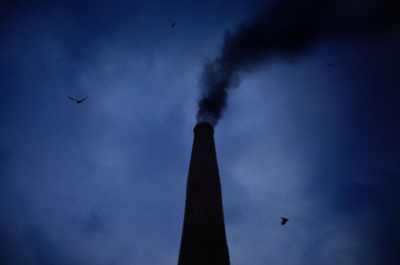Climate Responses to Soot Emissions
Soot, an important light-absorbing component of smoke, is a product of incomplete fossil fuel and wood combustion. Soot particles can exert a large warming influence on the Earth by absorbing sunlight in the atmosphere and darkening snow and ice surfaces. A study led by scientists at the U.S. Department of Energy’s Pacific Northwest National Laboratory examined global and regional Earth System responses to soot emissions originating in the Arctic, midlatitudes, and globally. While previous studies have focused on equilibrium temperature response, researchers—for the first time in a consistent set of experiments—examined variability of responses, the responses to different emission amounts, and the time scale of the temperature responses to soot emissions. The study found that eliminating present-day soot emissions would produce noticeable surface temperature changes for only limited regions of the globe.
The team found that earth system responses did not scale linearly with emissions; there was a weaker temperature response to stronger soot emissions. The study also showed that changes in soot emissions affected surface temperatures much faster than changes in another key driver of environmental change: greenhouse gas concentrations. Soot emissions occurring at current levels did not generally lead to surface temperature changes that were easily detected above the natural variations in the Earth System at most locations of the globe. The size of soot effects was small in this modeling study, and models often appear to disagree on the magnitude of soot’s impact on temperature. Resolving the differences will be challenging. This work concluded that soot effects should be studied using coupled models that allow interactions across the atmosphere, ocean and (land and ocean) ice and snow, and the environmental impacts needs to be evaluated in multiple earth system models to look for common signatures in the non-linear model responses in the presence of the very large variability present in this region.
Researchers examined global and regional earth system responses, nonlinearity, and short-term transient temperature responses to Arctic, midlatitude, and global soot emissions, which come from incomplete fuel or wood combustion. Analyzing a set of coupled Community Earth System Model simulations, they found that earth system responses do not scale linearly with soot emissions. Stronger soot emission perturbations had a lower relative impact on surface temperatures and changes in radiative fluxes. The study showed that present-day soot emissions may have caused detectable surface temperature changes for only limited regions of the globe. While soot has been thought to be a very strong human-caused agent of environmental change, perhaps second only to carbon dioxide, the study indicates this may not translate into proportional changes in the earth system. In regions where soot does have an effect, such as some areas within the Arctic, it affects surface temperatures much faster than greenhouse gases.

